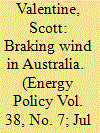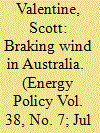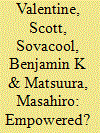| Srl | Item |
| 1 |
ID:
096732


|
|
|
|
|
| Publication |
2010.
|
| Summary/Abstract |
This paper provides a critical evaluation of Australia's new Renewable Energy Target (RET) program with respect to its capacity to support wind power development. Four structural flaws associated with the RET which undermine its effectiveness as a catalyst for technological change in the electricity sector are discussed: (i) the inclusion of waste coal mine gas (WCMG) as an eligible fuel source which acts as an indirect coal industry subsidy, (ii) program duration which is too short and ill-structured, (iii) a multiplier that is well-intended to support small-scale renewable technologies but which creates "phantom capacity", and (iv) the capped target of 45,000 GWh which will stymie long-term wind power market investment. The paper concludes with recommendations which stress the importance of passing effective Carbon Pollution Renewable Scheme (CPRS) legislation to offset the weaknesses associated with the RET. If an effective CPRS cannot be implemented, the paper recommends that amendments be made to the RET to (i) remove WCMG from the list of approved alternative energy sources, and (ii) extend the RET targets to reach 120,000 GWh by 2030.
|
|
|
|
|
|
|
|
|
|
|
|
|
|
|
|
| 2 |
ID:
097532


|
|
|
|
|
| Publication |
2010.
|
| Summary/Abstract |
This paper provides a critical evaluation of Australia's new Renewable Energy Target (RET) program with respect to its capacity to support wind power development. Four structural flaws associated with the RET which undermine its effectiveness as a catalyst for technological change in the electricity sector are discussed: (i) the inclusion of waste coal mine gas (WCMG) as an eligible fuel source which acts as an indirect coal industry subsidy, (ii) program duration which is too short and ill-structured, (iii) a multiplier that is well-intended to support small-scale renewable technologies but which creates "phantom capacity", and (iv) the capped target of 45,000 GWh which will stymie long-term wind power market investment. The paper concludes with recommendations which stress the importance of passing effective Carbon Pollution Renewable Scheme (CPRS) legislation to offset the weaknesses associated with the RET. If an effective CPRS cannot be implemented, the paper recommends that amendments be made to the RET to (i) remove WCMG from the list of approved alternative energy sources, and (ii) extend the RET targets to reach 120,000 GWh by 2030.
|
|
|
|
|
|
|
|
|
|
|
|
|
|
|
|
| 3 |
ID:
103529


|
|
|
|
|
| Publication |
2011.
|
| Summary/Abstract |
In August 2009, after 54 years of virtually unbroken rule, Japan's Liberal Democratic Party (LDP) was ousted from power by the Democratic Party of Japan (DPJ). The DPJ's campaign platform included a pledge to facilitate extreme reductions in greenhouse gas (GHG) emissions. Yet, at the COP16 meeting in Cancun, Japan announced that it would not accept further emission reduction targets without broader commitment from all nations. This paper seeks to explain this dichotomy by employing a targeted stakeholder evaluation based on surveys with 321 Japanese citizens to assess the extent to which influential stakeholder groups in Japan supports a potentially costly transition to a low-carbon energy infrastructure amidst severe economic challenges that the nation faces. Findings help explain Japan's adversarial role in COP16 negotiations in Cancun, despite the stated GHG reduction ambitions of Japan's current ruling party. The analysis concludes that if the DPJ does embrace aggressive CO2 reduction targets in the future, the strategic focus will likely mirror the former ruling party's energy policy of bolstering nuclear power generation capacity and promoting energy efficiency improvements while exhibiting lukewarm commitment to supporting capacity development in alternative sources of energy supply such as solar panels and wind turbines.
|
|
|
|
|
|
|
|
|
|
|
|
|
|
|
|